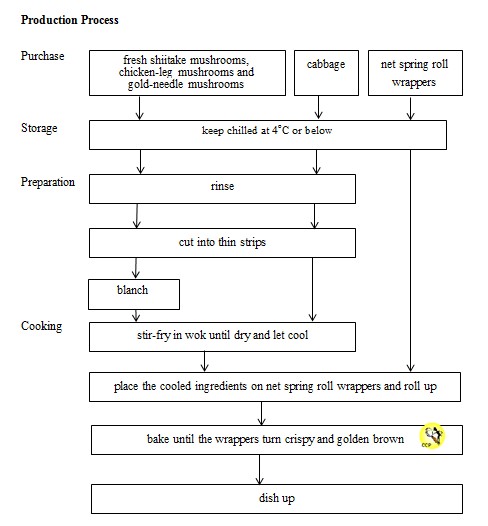
Published by the Centre for Food Safety
Feature Article
Mycotoxins in Food
What are the Sources of Mycotoxins in Food?
Mycotoxins are naturally occurring toxins produced by certain species of moulds and are toxic to humans. The better known examples include alfatoxins and ochratoxins. Some scientists suggest that the toxins, produced as a defence against other moulds and animals on their sources of food, normally develop before harvest and during storage of crops. The growth of toxin-producing fungi can occur in large varieties of crops such as cereals, oilseeds and fruits, which are susceptible to mould infestation under high temperature and high humidity. Crops under adverse planting conditions or threats of pest infestation are also vulnerable to moulds. Fungi may not be visible to the naked eye in infected grains due to processing, but the toxins may have already diffused into the grains during the growth period.
Although most mycotoxins in food are found in cereals and cereal products, the toxins may also exist in milk, livers and kidneys of animals fed on contaminated feed.
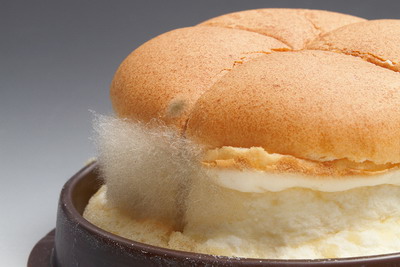
Mycotoxins can cause a wide range of adverse health effects in humans, like the disorders of the immune system, liver or kidney. Although acute mycotoxin poisoning is rare, persistent exposure to aflatoxins can lead to liver cancer.
Ways to Reduce Exposure to Mycotoxins
As mycotoxins are ubiquitous in nature, there is no way to totally eliminate them from food. Despite this, by observing good agricultural practices at various stages such as planting, pre-harvest, harvest, storage, transport, processing and distribution of crops, and adopting a management system for food production based on the principles of Hazard Analysis and Critical Control Points (HACCP), mycotoxin contamination in food can be reduced.
In order to minimise dietary exposure to mycotoxins, cereal products should be stored in cool and dry places or according to the storage instructions on the product labels. Never consume foods with the presence of visible moulds or obvious damage.
Responsibilities of the Food Trade
Trade members are advised to note the followings to reduce levels of mycotoxins in food to a minimum.
- Adopt the HACCP System and draw up a suitable Food Safety Plan.
- Source ingredients from reputable and reliable suppliers.
- Make sure that all ingredients conform to prescribed standards of food quality and safety.
- Maintain a good storage environment.
- Store foods in cool and dry places.
- Rotate stock on a first-in-first-out basis.
- Keep records of relevant critical control points.
Readers' Corner
Risks of Consuming Raw Eggs
Eggs are nutritious foods and form an important part of human diet. However, eggs are not laid in a sterile environment. Poultry is widely recognised to be a host for Salmonella. Eggs may be contaminated via two different routes: vertical transmission through the ovary of the hen (or transovarian transmission), or horizontal transmission through the shell of the egg (or trans-shell transmission).
Eggs and egg products are the major contributors of Salmonella food poisoning outbreak in many places, including Hong Kong. Generally, Salmonella can be destroyed by cooking food to a core temperature of 75oC for at least 30 seconds. Therefore, the risk of contracting Salmonella from thoroughly cooked eggs and egg products is low, whereas the risk of Salmonella infection from consuming raw or undercooked eggs and egg products is high. Symptoms of Salmonella infection include nausea, fever, abdominal pain, diarrhoea and vomiting. Infants, the elderly and people with lower immunity may develop more severe symptoms.
To minimise the potential risk of salmonellosis due to the consumption of eggs and egg products, good manufacturing and handling practices should always be observed. The followings are some advice to the trade:
(A) Handling of Raw Materials
- Purchase raw materials from hygienic and reliable shops or suppliers;
- As a general rule, eggs need not be washed. However, if eggs are soiled with faecal matter of the hen, they can be washed with water. Washed eggs should be cooked immediately;
- Avoid using cracked eggs as they are more likely to be contaminated and thus present a higher health risk;
- Adopt a first-in-first-out principle to store raw materials and keep them at appropriate temperatures;
- Observe "best before" date and avoid using expired materials;
- Avoid keeping chilled ingredients and finished products at above 4oC for more than 2 hours.
(B) Manufacturing and Storage
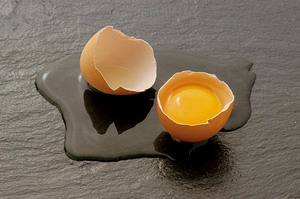
- Store shell eggs under refrigeration;
- Cook eggs until all parts reach a minimum temperature of 75oC and both the yolk and the white are firm. Prepare scrambled and fried eggs in small portions and eggs should be stir-fried or pan-fried until they are firm (not runny throughout);
- Avoid preparing ready-to-eat dishes and foods consumed raw at the same time;
- Avoid preparing dishes in large quantities each time and too early;
- Store and transport eggs and egg products intended to be served cold at 4oC or below;
- Display eggs and egg products for sale in a proper manner and at 4oC or below;
- Prevent cross-contamination among raw eggs and other foods.
(C) Equipment, Utensils and Personal Hygiene
- Establish a cleaning and disinfection programme to clean and sterilise equipment and utensils including refrigerators, chopping boards, choppers, containers and mixers;
- Observe good personal hygiene. Food handlers should wash their hands with soap and water thoroughly before preparing food and after an interruption in food preparation occurs, particularly after using the toilet.
Relationship between Cooking Temperature and Food Safety
Food substances are chemical in nature. Theoretically, as long as a process causes chemical changes in food, it will generate chemicals and some of them could be harmful. Process contaminants are chemical substances that are produced in food during food manufacturing, cooking (including home cooking), packaging and other processing activities.
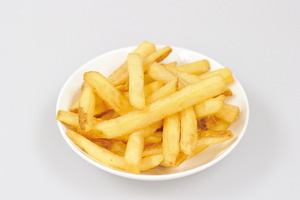
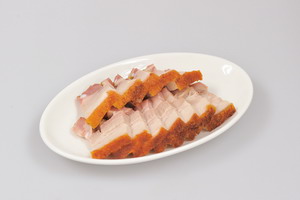
Examples of process contaminants produced by dry-heat cooking include acrylamide in French fries and PAHs in roasted pork.
Dry-heat Cooking
In dry-heat cooking, either air or fat is used as the medium of cooking. A higher temperature will be achieved as compared with moist-heat cooking, which uses water and steam as the medium of cooking. Some common process contaminants such as acrylamide, polycyclic aromatic hydrocarbons (PAHs) and heterocyclic amines (HCAs) will be formed during dry-heat cooking.
| Methods | Examples | Cooking Temperatures |
|---|---|---|
| Dry-heat cooking | Deep-frying | Around 160°C to 180°C |
| Baking | Up to around 220°C | |
| Charcoal grilling | Up to around 370°C | |
| Gas/electric grilling | Up to around 315°C | |
| Moist-heat cooking | Steaming | Around 100°C |
| Boiling | Around 100°C |
Risk of PAHs in Barbecued Meats
PAHs refer to a large group of organic chemicals containing rings of carbon and hydrogen atoms. PAHs are present everywhere in the environment as pollutants in air, soil, water and foods. Formed during incomplete combustion of fuels and organic substances, PAHs are also found in vehicle emissions and tobacco smoke.
In view of our concern on the carcinogenicity of PAHs and their damage on genetic materials inside cells, it is not possible to establish an intake level without risk. The Joint Food and Agriculture Organization/World Health Organization Expert Committee on Food Additives (JECFA) is of the view that the intake of PAHs should be as low as practicable. In its evaluation of PAHs in 2005, JECFA concluded that the dietary intakes of PAHs were of low concern for human health. JECFA recommended some measures to reduce the intake of PAHs such as avoiding direct contact of foods with flames, and cooking with the heat source above the food, etc.
The Food and Environmental Hygiene Department (FEHD) conducted a study on PAHs in 2004. Samples of barbecued meats, including siu mei (namely roasted pork, BBQ pork and roasted ducks) and dried meats (namely beef jerky and pork jerky) were collected and analysed. It was found that a higher cooking temperature or a shorter distance between the food and the heat source would give rise to higher PAHs levels in the food. Furthermore, the total PAHs levels in roasted ducks were higher on the skin and in the fat portion (the outer part); and charcoal grilled foods contained more PAHs than foods prepared by gas grilling or electric oven roasting. Nevertheless, it was also found that the total PAHs levels in siu mei prepared by electric oven roasting or gas grilling were similar to PAHs levels in other foods reported in overseas studies. In other words, siu mei prepared in these ways was not a particular high risk food item.
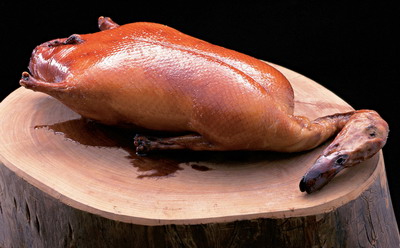
Reducing Process Contaminants
The formation of process contaminants in food is unavoidable but they can be reduced by, for instance, lowering the cooking temperature and reducing the cooking time. International and national food safety authorities and food industries have been investigating the mechanisms of the formation of process contaminants in food, developing ways to reduce the formation of process contaminants in industrial processing and domestic cooking, as well as conducting food product surveys to gain up-to-date information in relation to health risk assessments.
Advice to the Trade
- For preparing siu mei, use gas grilling or electric oven roasting instead of charcoal grilling. As for dried meat, it is preferable to use electric grilling instead of gas grilling;
- Avoid direct contact of meat with flames and dripping of fat onto the heat source (this can be achieved by the trimming of visible fat from meat before barbecuing and proper design of the heating chamber);
- Cook the meat at the lowest possible temperature and avoid overcooking. However, the meat must be cooked thoroughly to destroy foodborne pathogens; and
- Cook the meat partially by a method which employs a lower cooking temperature (such as boiling) prior to grilling or roasting.
Info Corner
Food Safety Tips
Separate Raw Food from Ready-to-eat or Cooked Food When Making Purchase
- Pick prepackaged and canned foods first, and shop for raw food (e.g. raw meat, poultry and seafood) last.
- Separate raw food items from other food items in grocery cart and shopping bags to prevent the juice from contaminating other food items.
News on New Dishes
Safety Tips on Preparing a Vegetarian Dish - Mushroom Rolls with Herbs
Thanks to today's new trends, vegetarian food is no longer confined to the traditional recipes. There are Chinese, Western, Japanese, and many other styles. In this issue, we are honoured to have invited Chef LI Wing-keung, Head Chef of Gaia Veggie Shop (Wong Tai Sin Branch), a signatory of the Food Safety Charter, to demonstrate how to prepare a vegetarian dish - Mushroom Rolls with Herbs. This dish, with mushrooms as the main ingredients, blends the Chinese cooking method with the Western one.
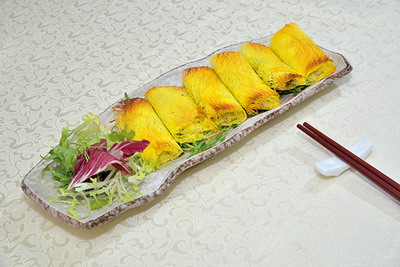
| Preparation Steps | Small Tips, Big Wisdom | ||
|---|---|---|---|
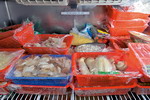 |
Receiving | First, purchase fresh shiitake mushrooms, chicken-leg mushrooms, gold-needle mushrooms, cabbage, net spring roll wrappers and other ingredients from approved and reliable suppliers. | Upon receipt of the ingredients, check with meticulous care to ensure their freshness. Special attention should be paid to the mushrooms to make sure that there are no signs of spoilage (with coloured spots / abnormal smell / slime). Mushrooms and vegetables should be kept under refrigeration at 4oC or below. |
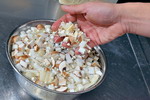 |
Rinsing | Soak and rinse vegetables (including fresh shiitake mushrooms, chicken-leg mushrooms and gold-needle mushrooms) thoroughly. | Soaking makes the mushrooms tender. Apart from preparing the mushrooms for further handling, soaking helps remove effectively the impurities such as sand and mud as well as any possible pesticide residues. |
 |
Cutting | Dice / cut the fresh shiitake mushrooms, chicken-leg mushrooms, gold-needle mushrooms and cabbage. | Dicing the ingredients makes it easier to cook them thoroughly and hence shortens the cooking time. |
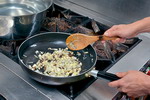 |
Stir-frying | Blanch the diced mushrooms (fresh shiitake mushrooms, chicken-leg mushrooms and gold-needle mushrooms) and cabbage. Drain well and stir-fry with herbs in wok for about 2 minutes until dry. Add an appropriate amount of seasoning and set aside to let cool. | Making the mushrooms tastier and more tender, blanching can speed up the cooking process and ensure that they are thoroughly cooked. |
 |
Rolling | Place the mushroom mixture at one end of the wrapper and roll up just like spring roll. | The filling should be dry in order not to tear the wrapper.
Remove the packaging of the wrappers only when the rolling process is about to start so that they can remain fresh and soft. |
 |
Baking | Preheat the oven to 150oC. Put the mushroom rolls with herbs and butter into the oven and bake them for 10 to 12 minutes or until they turn crispy and golden brown. | Pre-set the correct time and temperature for baking. |

Tips from Chef LI:
- To make a good dish, it is essential to use fresh ingredients. As mushrooms and vegetables are perishable food, Gaia Veggie Shop will place orders with reliable suppliers according to the estimated usage of that day. Upon receipt of the ingredients, the shop will check and ensure that the vegetables are not damaged or bruised, and the mushrooms are dry without coloured spots, abnormal smell and slime.
- Blanching can help remove the unpleasant smell of mushrooms, preserve the bright colour as well as the crisp and tender texture of vegetables, bring out the natural flavour of vegetables and shorten the stir-frying time. Particular attention should be paid to the control of heat during the blanching process. If the blanching time is longer than necessary, the ingredients will turn pale in colour and no longer be crisp and tender.
- After blanching, mushrooms and vegetables must be well drained and stir-fried with medium to high heat until all moisture has evaporated. Only in this way can the ingredients become dry and fragrant so as to avoid tearing the wrapper when rolling up the ingredients.
- As compared to deep frying in oil, baking not only keeps the food crisp but also reduces the use of cooking oil and the generation of cooking fumes, benefiting. This is good for the health of both customers and the chef.
Food Safety Plan Corner
Mushroom Rolls with Herbs
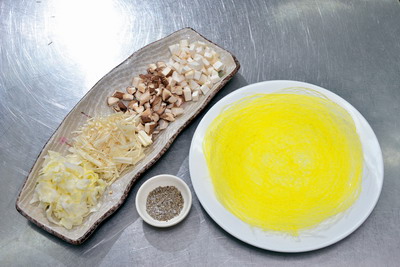
Ingredients:
Fresh shiitake mushrooms, chicken-leg mushrooms, gold-needle mushrooms, cabbage and net spring roll wrappers
Seasoning:
Salt and sugar
Steps:
- Rinse all mushrooms and cabbage and cut them into thin strips.
- Blanch the mushrooms.
- Stir-fry the mushrooms and cabbage with seasoning until dry and let cool.
- Place the mushrooms and cabbage on net spring roll wrappers and roll up.
- Bake in oven (for about 10 to 12 minutes) until the wrappers turn crisp and golden brown. Ready to serve.
Production Process
Critical Control Point (CCP)
It is a step or procedure in a food manufacture process at which control can be applied and as a result, food safety hazard can be prevented or eliminated.
There is one Critical Control Point in the production of Mushroom Rolls with Herbs:
- Preheat the oven and ensure that the temperature and baking time are correct. Food should be cooked thoroughly before consumption.
Briefing of Activities
Facebook官方專頁 
Facebook Page
To facilitate better communication and interaction with the public, the Centre for Food Safety (CFS) of the FEHD launched on 1 October 2013 its Facebook page(www.facebook.com/CentreforFoodSafety)as an additional channel to disseminate important information on food safety and health more quickly and directly to Facebook users.
The CFS Facebook page contains a wide range of information including food alerts, food safety reports, food safety tips, results of theme studies and publications issued by the CFS. In addition, members of the public can also view again the Announcements in the Public Interest produced by the CFS as well as highlights and photographs of publicity activities on food safety. The CFS will also upload information on food safety-related seminars and workshops to keep users posted.

All members of the public are welcome to visit, "like" and share the CFS Facebook page. 
Upcoming Activities
"High Risk Food" – Food Safety Talks
In response to the Western Pacific Regional Food Safety Strategy 2011-2015 of the World Health Organization (WHO), the CFS will organise food safety talks on "High Risk Food" in all districts in Hong Kong from now till 2015. The objective is to promote food safety awareness among food handlers engaged in handling high-risk food (such as sushi, sashimi, oysters and meat to be consumed raw). The talks will be conducted in Cantonese and free of charge.
Food premises will receive invitation letters and enrollment forms providing details including the dates, time and venues of the talks to be held in respective districts. Food handlers, if interested, may call the CFS on 2867 5147 for enquiries from 9:00 am to 12:00 noon and 2:00 pm to 5:00 pm on Monday to Friday (except public holidays).
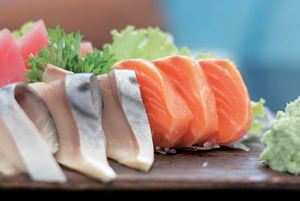
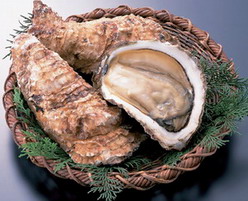
Food Safety Q&A
Is your intake of iodine adequate?
Contrary to popular belief, iodine deficiency can occur in developed countries or coastal areas where seafoods are abundant. Studies found that individuals living in areas with severe iodine deficiency could have intelligence quotient (IQ) of up to 13.5 points below those in areas without such problem.
Iodine Intakes at Global and Local Levels
According to a report released by WHO in 2007, about 31% of the world's population was estimated to have insufficient iodine intakes, with pregnant/lactating women, infants/young children and South-East Asians as the three most vulnerable groups. In 2003, the Hong Kong Expert Panel Group on Iodine Deficiency Disorders, formed by local academics and experts, also examined local data and considered borderline iodine deficiency existed in some local expectant mothers.
WHO's Recommended Iodine Intake (μg/day)
| Preschool children (0 to 59 months) | 90 |
|---|---|
| Schoolchildren (6 to 12 years) | 120 |
| Adolescents (above 12 years) and adults | 150 |
| Pregnant and lactating women | 250 |
To understand the local situation, the CFS collected local food samples and assessed the dietary iodine intake among Hong Kong adults in 2009. The food consumption data was obtained from the Hong Kong Population-based Food Consumption Survey 2005-2007. The report, which was released in 2011, revealed a median iodine intake of 44 μg/day in the local population and an iodine intake of 93% of the adult population below WHO's recommendation.
Meeting the Dietary Iodine Requirement
While updated clinical and biochemical (e.g. urinary iodine level) data would help further evaluate the actual health effects on humans, the current findings suggest that the population may need to pay attention to their iodine intake. A note of caution: patients with underlying thyroid diseases and people with very low exposure to iodine for a prolonged period should consult their doctors and are not recommended to increase iodine intake suddenly.
To meet their dietary iodine requirement, people vulnerable to iodine deficiency should consider the following approaches:
Consume Foods High in Iodine

The human body actually needs only a small amount but regular daily intake of iodine (see WHO's recommended iodine intake in the table above). When ingested in large amounts, iodine is readily excreted through the kidneys into the urine. While excessive iodine intake for a long time may disrupt the normal functions of the thyroid gland, the tolerable daily intake for healthy adults up to 1 000 μg/day.
The public is advised to include foods that are rich in iodine in their daily dietary choice and take precautions to reduce iodine loss as iodine may dissolve in water during cooking. To retain the maximum amount of iodine in food, the public may steam or stir-fry foods with less oil, and cook clean crustaceans intact.
According to the findings of the study announced by the CFS, the following food groups are rich in iodine (μg/kg):
| Dried kelp and laver | 8 900 – 2 600 000 |
|---|---|
| Seaweed snack and nori sheet for sushi | 6 400 – 38 000 |
| Shellfish and marine fish | 32 – 2 100 |
| Dairy products | 40 – 1 400 |
Including iodine-rich foods, such as (a) shellfish and marine fish and (b) seaweeds, in the diet helps to meet iodine requirement.
Use of Iodised Salt in the Diet
WHO has recommended iodised salt as the solution for countries where iodine deficiency is of public health concern. Iodised salt is not yet widely available in Hong Kong though around 70% of households throughout the world have access to it.
Regarding the quantity, WHO considers that replacing 5 g of ordinary salt from all sources in an adult's diet with iodised salt each day is generally safe. This will add an extra 100 to 200 μg of iodine to the daily diet, if the salt is fortified according to WHO's recommendation at 20 to 40 mg iodine per kg of salt.
When used in domestic setting, iodised salt should be stored in a tight and coloured container at a cool dry place and preferably added immediately before the food is served. It is because the iodine contained in iodised salt is generally unstable and may be lost due to humidity and exposure to heat and sunlight.
Key Points to Note:
- Insufficient iodine intake is a global health concern.
- Seaweeds and seaweed products, shellfish and dairy products are rich in iodine.
- WHO recommends using iodised salt to replace table salt to prevent iodine deficiency.
Advice to the Trade
- Keep iodised salt available to the public.
- Provide proper labelling of iodised salt, such as instructions on its usage, to minimise its iodine loss.
- Indicate the amount of iodine on the label of iodised salt.
Truth against Fallacy
Has colouring matter been added if there is colour seepage in the handling of fruits and vegetables? How is colouring matter regulated in Hong Kong?
The CFS receives from time to time complaints about suspected artificial colours exuded from vegetables such as purple sweet potatoes and eggplants during washing or cooking. After investigation, these food items were found to contain naturally occurring colours and there was no evidence that artificial colours had been intentionally added. In fact, it is a normal phenomenon that colours naturally present in fruits and vegetables (e.g. anthocyanins in sweet potatoes and red cabbages; lycopenes in tomatoes; anthocyanins in eggplants; and carotenes in carrots) will exude during food preparation. For instance, upon investigation and testing in response to the suspicious use of colouring matter in purple sweet potatoes, it was revealed that all samples of purple sweet potatoes contained a purple pigment known as anthocyanin. It is a naturally occurring colour found in purple sweet potatoes and there is no evidence that the colour has been added to them. In fact, anthocyanins are naturally present in many edible fruits and vegetables such as grapes, red cabbages and berries, and are generally innocuous for human consumption. Colour seepage is a natural phenomenon that often occurs during the handling of fruits and vegetables, and is nothing to be worried about.
How is colouring matter regulated in Hong Kong?
The types of colouring matter permitted for food use are specified under the Colouring Matter in Food Regulations (Cap. 132H). It is also stipulated that no meat, game, poultry, fish, fruit or vegetable in a raw and unprocessed state shall be added with any colouring matter. Starting from July 2007, food additives including colouring matter in prepackaged food available in Hong Kong must be listed by their functional classes and specific names or identification numbers under the International Numbering System for Food Additives with or without the prefix "E" or "e" on the food label.
Advice to the Trade
- For food manufacturers, use only the permitted colouring matter in food with the quantity added limited to the lowest possible level necessary to accomplish its desired effect.
- Ensure that accurate information, including the specific natural colouring matter used, is provided on the labels of prepackaged food.
- For retailers, stop selling fresh food suspected to have colour added.
Brain Gym
True or False
- For prepackaged food labelled as "low sodium", it must contain not more than 120 mg of sodium per 100 g of food.
- Trans fats, also called trans fatty acids, are a type of saturated fats.
- Loss of nutrients from washing vegetables under running water is less than that from soaking vegetables.
- The control of vitamin and mineral supplements in the form of tablets, capsules, etc., lies within the purview of the Department of Health.
Answers: (1) Yes; (2) No; (3) Yes; (4) Yes.
Enquiry and Subscription
Printed copies of the Food Safety Express can be obtained from the Communication Resource Unit located at 8/F, Fa Yuen Street Municipal Services Building, 123A Fa Yuen Street, Mong Kok, Kowloon. For enquiry, please call 2381 6096. The public may also visit the website of the CFS (http://www.cfs.gov.hk) for the online version.
